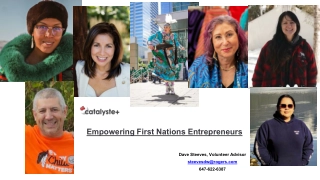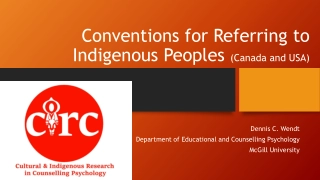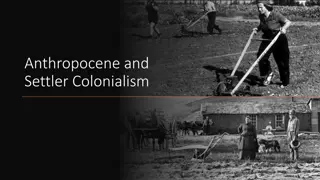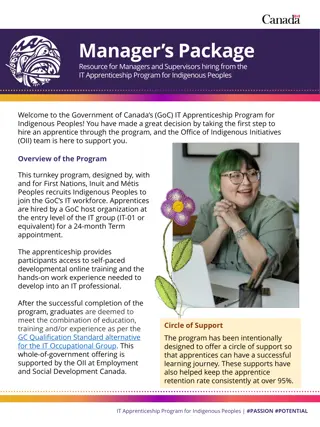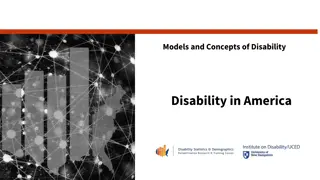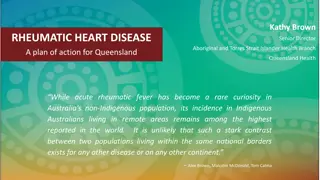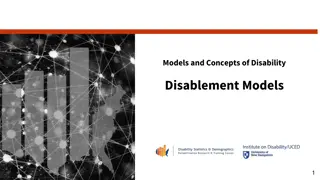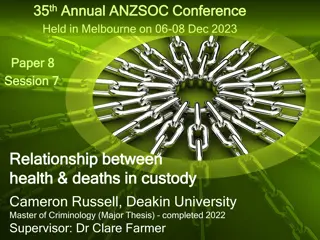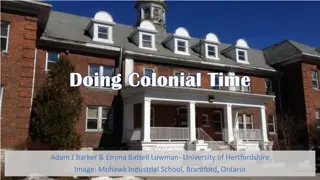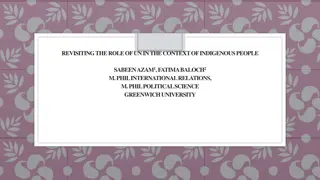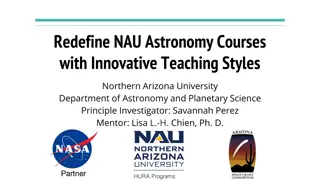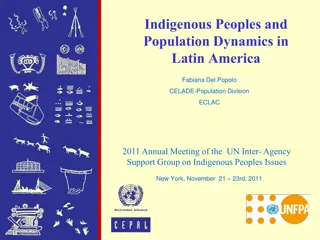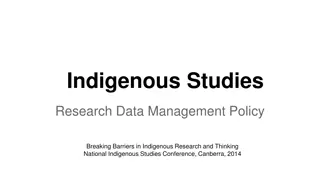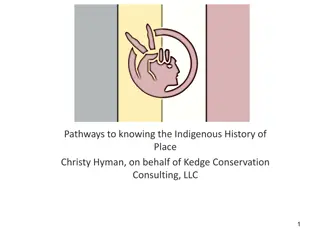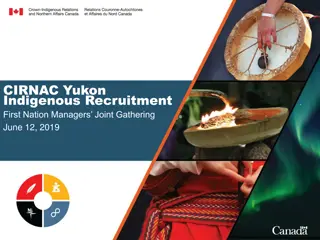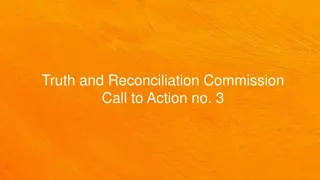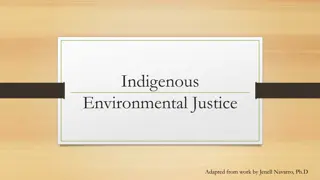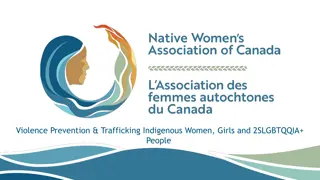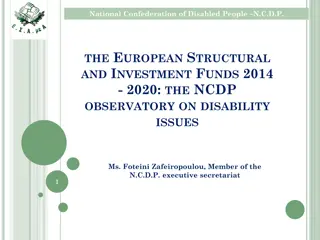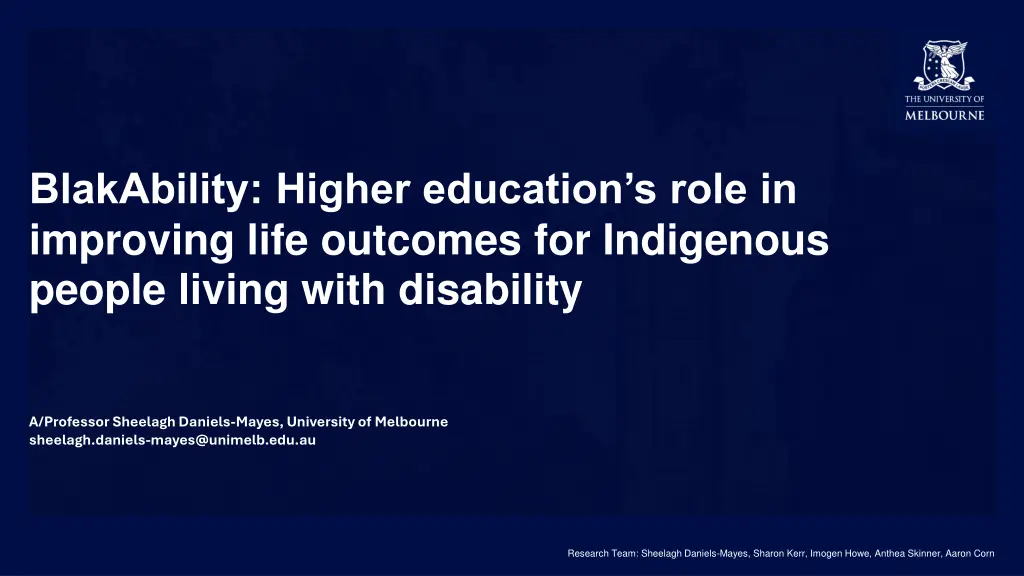
Improving Indigenous Life Outcomes Through Higher Education Engagement
Explore the role of higher education in enhancing life outcomes for Indigenous individuals living with disabilities, as highlighted by Professor Sheelagh Daniels-Mayes and her research team at the University of Melbourne. Embracing the concept of BlakAbility, the team focuses on acknowledging Indigenous perspectives and promoting inclusivity through culturally informed approaches. Discover the positive impact of education in empowering Indigenous communities.
Uploaded on | 0 Views
Download Presentation

Please find below an Image/Link to download the presentation.
The content on the website is provided AS IS for your information and personal use only. It may not be sold, licensed, or shared on other websites without obtaining consent from the author. If you encounter any issues during the download, it is possible that the publisher has removed the file from their server.
You are allowed to download the files provided on this website for personal or commercial use, subject to the condition that they are used lawfully. All files are the property of their respective owners.
The content on the website is provided AS IS for your information and personal use only. It may not be sold, licensed, or shared on other websites without obtaining consent from the author.
E N D
Presentation Transcript
BlakAbility: Higher educations role in improving life outcomes for Indigenous people living with disability A/Professor Sheelagh Daniels-Mayes, University of Melbourne sheelagh.daniels-mayes@unimelb.edu.au Research Team: Sheelagh Daniels-Mayes, Sharon Kerr, Imogen Howe, Anthea Skinner, Aaron Corn
Acknowledgement of Country The University of Melbourne acknowledges the Traditional Owners of the unceded land on which we work, learn and live: the Wurundjeri Woi-wurrung and Bunurong peoples, the Yorta Yorta Nation, and the Dja Dja Wurrung people. We pay respect to Elders past, present and future, and acknowledge the importance of Indigenous knowledge in the Academy. As we come together today, we would like to reflect on disability and acknowledge the holistic perspectives that Indigenous cultures bring to our understanding of ability, disability, and inclusion. We acknowledge that many Indigenous worldviews emphasise the inherent value and unique contributions of all individuals, regardless of ability. We recognise that true inclusion in education means respecting and learning from diverse cultural understandings of health, well-being, and ability. This includes acknowledging the intersectionality of Indigenous experiences with disability, and the importance of culturally informed approaches to inclusive teaching and research practices. As a community of researchers, teachers, professional staff and students we are privileged to work and learn every day with Indigenous colleagues and partners as we strive for an educational and research environment that embraces, values and supports all learners, researchers and knowledge brokers, including those with disabilities.
Get my feathers on Photo of a Crow 3
Emily Jane Orchard Born approx. 1942, died 1970.
The BlakAbility research team BlakAbility is the term developed by Dr Sheelagh Daniels-Mayes to describe Aboriginal and Torres Strait Islander People who live with disability. BlakAbility is a positive term and reflects the Indigenous perspective of disability that doesn t focus on what people can t do, but rather what they can do. It is a community approach to human value. More information: https://blogs.unimelb.edu.au/blakability/about-us/ Imogen Howe; Aaron Corn; Sheelagh Daniels-Mayes; Ros Sackler (governance); Sharon Kerr; Anthea Skinner
Australian Australian Population Population 27 million 5.5 million 20% 20%
Aboriginal & Torres Aboriginal & Torres Strait Islander Strait Islander Australian Australian Population Population 27 million 5.5 million 20% 20% 45% 45%
Impact of the problem? For First Nations peoples with a disability, life in modern Australia is marked by isolation, discrimination and inequality (Avery, 2019). It is difficult to think of any more disadvantaged Australians than Aboriginal and Torres Strait Islander people with disability. Poorest outcomes of any group in Australia mainly due to the impact of colonisation (Cronin 2003; Gilroy et al. 2016; McGlade 2003; Soldatic 2018). Scant knowledge about the impact of intersectional and institutionalised experiences of mistreatment and discrimination on service access like hospitals, disability services, education, employment (Gilroy et al.; Hollinsworth). Damian Griffis, 2023 Royal Commission into Violence, Abuse, Neglect and Exploitation of People with Disability
Its a big problem! Let s remember, each number, each statistic, is a person s life Let s remember, each number, each statistic, is a person s life
Understanding deficit discourse Deficit discourse refers to disempowering patterns of thought, language and practice that represent people in terms of deficiencies and failures. It particularly refers to discourse that places responsibility for problems with the affected individuals or communities, overlooking the larger socio-economic structures in which they are embedded (Fogarty et al, 2018). While we might think of discourse as just language , research has shown that it is inseparable from our understandings of the world and how we act. As such, discourse plays a fundamental role in resource and power inequalities. (Fogarty et al, 2018) Discourses are both constitutive of and embedded in social, political and cultural practices (Gee, 1990; 2004; MacLure, 2003; Rogers, 2004).
Deficit discourses of Indigeneity and disability Absence, lack, failure or deviance Indigeneity Disability Aboriginal and Torres Strait Islander people were in the past often portrayed as primitive or backwards. Current-day deficit discourse is influenced by these negative race-based stereotypes (sometimes overtly, other times subtly), and in some respects reinforces them. When people reproduce deficit discourse, they often have good intentions but are not fully aware that they are drawing on discredited social constructs. The concept of there being a set of norms, which are subsequently positioned as the ideal, requires the notion of the abnormal or deviance in the population . The abnormal becomes anything that deviates from established norms. This development of the construct of statistically defined norms in relation to human attributes and behaviour and the acceptance that human traits and characteristics are universal, that they can and should be defined, measured and ranked in relation to established norms , has become accepted as part of the natural order of things (Davis, 1997). Rejecting deficit discourse is not about pretending that Aboriginal and Torres Strait Islander people face no challenges, nor about downplaying those challenges. Discussion of socio-economic disadvantage, and ways to alleviate it, is important and necessary. Rather, discourses of deficit occur when discussion of Aboriginal and Torres Strait Islander affairs is reduced to a focus on failure and dysfunction, and Aboriginal and Torres Strait Islander identity becomes defined in negative terms, eclipsing the complex reasons for inequalities, and overlooking diversity, capability and strength. (Fogarty et al, 2018) Discourses of normal as opposed to disabled . It is not the persons with disabilities that have the right to define this but those who are in positions of power (Ben-Moshe and Magana).
Models of disability Moral/Religious and Charitable Models disability viewed as a personal tragedy or punishment for sin (Henderson & Bryan, 2004) to be feared or pitied. Moral model understands disability as a punishment from God or a result of immoral action. Economic Model Focuses on how much a disability prevents a person from working. It evaluates disabilities financial impact to the individual, their employer and the state. Social Model, Affirmative and Human Rights Models (resulting from decades of activism) recognise individual right to self-determination and autonomy as well as full inclusion in society disability is understood as a condition not existing solely within an individual but as a phenomenon that occurs at the intersection between a person and their physical, social and/or systemic contexts. Medical, Individualistic and Deficit/deficient Models disability viewed as an individual pathology to be overcome, fixed or eliminated by medical intervention and technology such as surgery, rehabilitation and digital innovations. Implies and inherent weakness or incapability or worth.
Silos of equity: Colonial load and Dis load Indigenous People who are both Employees + Students Indigenous people with disability who are both Employees + Students Indigenous Employees Indigenous Students Employees who are both Students who are both Indigenous + Disabled Indigenous + Disabled Disabled Employees Disabled Students People with Disability who are both Employees + Students
Navigating higher education Colonial Load Cripp Time Transgenerational trauma Uphold Cultural responsibilities against largely hostile systems Extratime needed to complete a task due to disability Educate others Inflexibility to manage situations in the way that best suits needs Stolen Generations Educate others Extra time to plan (e.g. traveling, going to a meeting, getting to class) First in family Eugenics Eugenics Sorry Business Low expectations Institutionalisation Hyper incarceration Racism Manage health regime Low expectations Demand on small number of Knowledge Holders and community leaders Proving you are Indigenous Live with exhaustion, pain Ableism Proving you have a disability Cognitive load (e.g. having to memorise)
Introducing intersectionality Intersectionality promotes an understanding of human beings as shaped by the interaction of different social locations (e.g., race /ethnicity, Indigeneity, gender, class, sexuality, geography, age, disability/ability, migration status, religion). These interactions occur within a context of connected systems and structures of power (e.g., laws, policies, state governments and other political and economic unions, religious institutions, media). Through such processes, interdependent forms of privilege and oppression shaped by colonialism, imperialism, racism, homophobia, ableism and patriarchy are created. (Hankivsky, 2014) race /ethnicity Age Indigeneity Geography Gender Sexuality Class
Intersectionality at work A person can simultaneously experience both power and oppression in varying contexts, at varying times (Collins, 1990). Relationships and power dynamics between social locations and processes (e.g., racism, classism, heterosexism, ableism, ageism, sexism) are linked. They can also change over time and be different depending on geographic settings. Scholars, researchers, policy makers, and activists must consider their own social position, role and power when taking an intersectional approach. This reflexivity, should be in place before setting priorities and directions in research, policy work and activism. People's lives can not be reduced to one single category of difference or inequity; Intersectionality is explicitly oriented towards transformation, building coalitions among different groups, and working towards social justice.
Cultural understandings of disability Conventional constructions of disability as a barrier to individual capacity and participation in society do not resonate with First Nations peoples (Avery, 2018; Hollinsworth, 2013) No equivalent term or concept corresponding to disability has been found in Australian indigenous languages (Avery, 2018; King, Brough & Knox, 2014). According to Avery, words and phrases exist in Australian First Nations languages that describe specific conditions such as blindness, deafness, mobility difficulties and back pain. Yet, these descriptors are not used in a negative or pejorative manner (Avery, 2018, p.5) First Nations people often see conditions to be unremarkable and to simply represent the normal range of human diversity particularly in the case of physical conditions. Within First Nations communities disability is not generally viewed as something that is separate or an impairment but rather as an element of the general disadvantage facing communities and families (Gilroy et al. 2018; Hollinsworth 2013).
Power as opportunity for change From an intersectional perspective, power is relational. A person can simultaneously experience both power and oppression in varying contexts, at varying times (Collins, 1990). These relations of power include experiences of power over others, but also that of power with others (power that involves people working together) (Guinier & Torres, 2003).
Further reading Acker-Verney, J. M. (2016). Embedding Intersectionality and Reflexivity in Research: Doing Accessible and Inclusive Research with Persons with Disabilities. Third World Thematics: A TWQ Journal 1 (3): 411 424. doi:10.1080/23802014.2016.1235468. Avery, S. (2018). Culture is Inclusion: A Narrative of Aboriginal and Torres Strait Islander People with Disability, First Peoples Disability Network Australia. Barber, D. (Eds.) Redefining Disability. (pp. 73-82). Leiden, The Netherlands: Brill. Ben-Moshe, L., and S. Magana. 2014. An Introduction to Race, Gender, and Disability: Intersectionality, Disability Studies, and Families of Color. Women, Gender, and Families of Color 2 (2): 105 114. doi:10.5406/womgenfamcol.2.2.0105. Daniels-Mayes, S. (2023) The urgent need Daniels-Mayes, S. (2022). Chapter 8 Misfit in the Academy: Succeeding as a Visually Impaired Scholar in Australia. In Bones, P., Gullion, J., Fogarty, W., Lovell, M., Langenberg, J., & Heron, M. J. (2018). Deficit discourse and strengths-based approaches. Changing the Narrative of Aboriginal and Torres Strait Islander Health and Wellbeing Melbourne: The Lowitja Institute. Gillborn, D. (2015). Intersectionality, critical race theory, and the primacy of racism: Race, class, gender, and disability in education. Qualitative inquiry, 21(3), 277-287. Hankivsky, O. (2014) Intersectionality 101. Canada: The Institute for Intersectionality Research & Policy, SFU Hollinsworth, D., Raciti, M., & Carter, J. (2021). Indigenous students identities in Australian higher education: Found, denied, and reinforced. Race Ethnicity and Education, 24(1), 112-131.
Further reading (cont.) King, J. A., M. Brough, and M. Knox. (2014). Negotiating Disability and Colonisation: The Lived Experience of Indigenous Australians with a Disability. Disability & Society 29 (5): 738 750. doi:10.1080/09687599.2013.864257. Marchetti, E. (2008). Intersectional Race and Gender Analyses: Why Legal Processes Just Don t Get It. Social & Legal Studies 17 (2): 155 174. doi:10.1177/0964663908089609. Mellifont, D., Watharow, A., Daniels-Mayes, S., Smith-Merry, J., & O'Donovan, M. A. (2024). Ethical Inclusion and Participation of People with Disability in Research: Problematising Vulnerability. In Advances in Disability Research Ethics (pp. 71-90). Emerald Publishing Limited. Perry, L., & Holt, L. (2018). Searching for the Songlines of Aboriginal education and culture within Australian higher education. The Australian Educational Researcher, 45, 343-361. Soldatic, K. (2018). Disability Poverty and Ageing in Regional Australia: The Impact of Disability Income Reforms for Indigenous Australians. Australian Journal of Social Issues 53 (3): 223 238. doi:10.1002/ajs4.51. Stone, E., & Priestley, M. (1996). Parasites, pawns and partners: Disability research and the role of non-disabled researchers. British Journal of Sociology, 47(4), 699 716.

